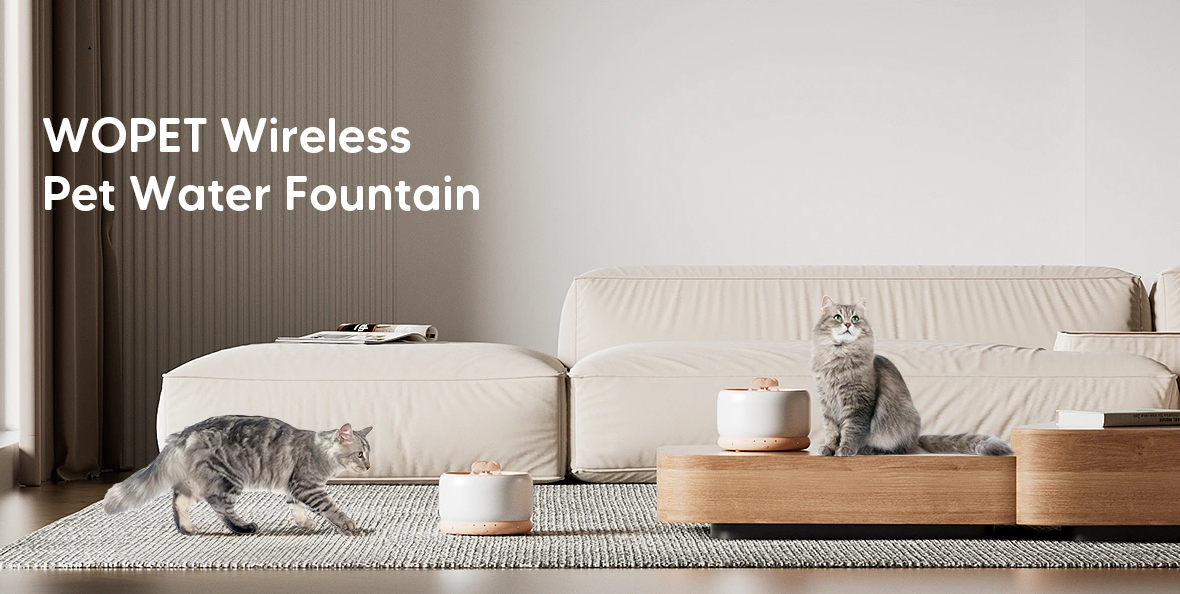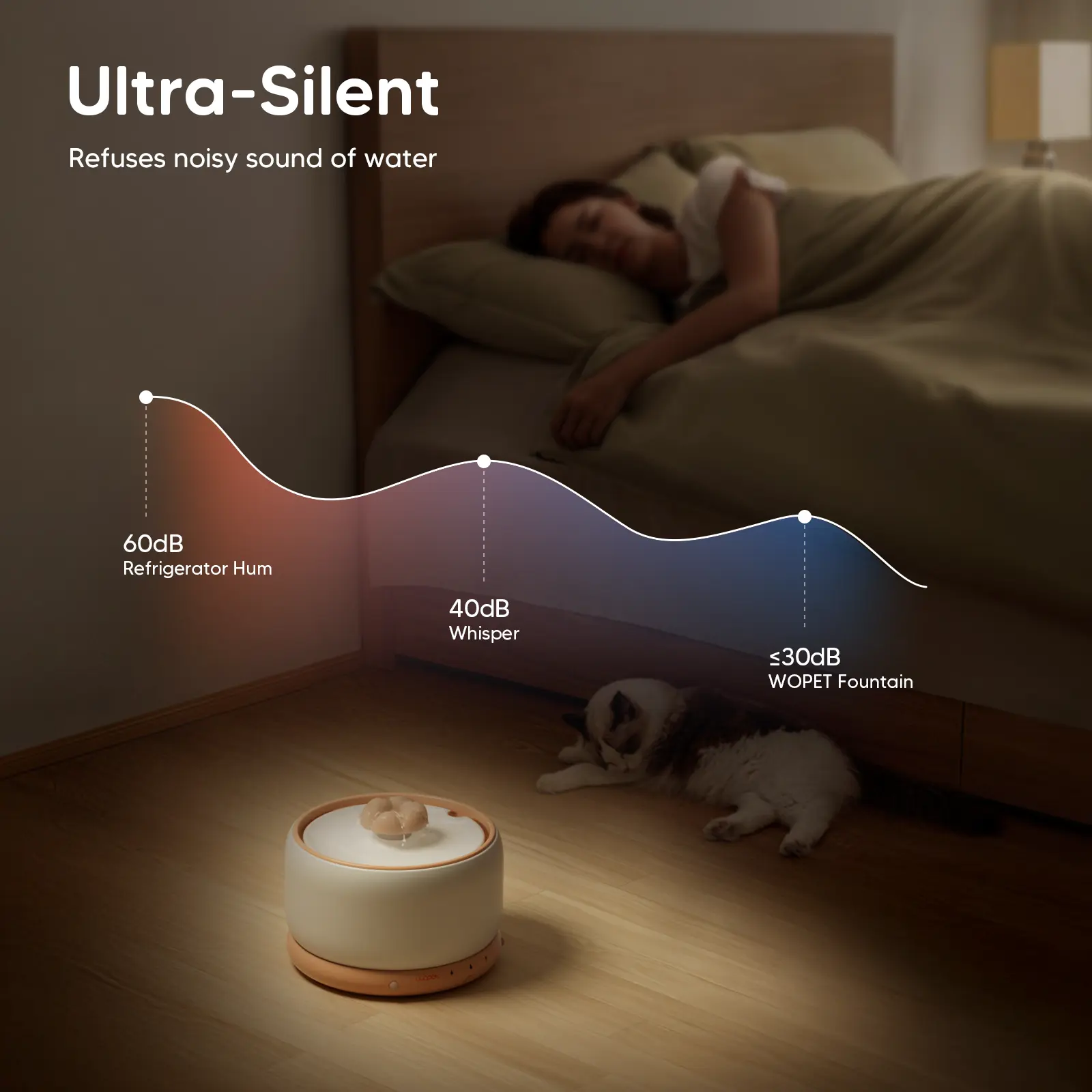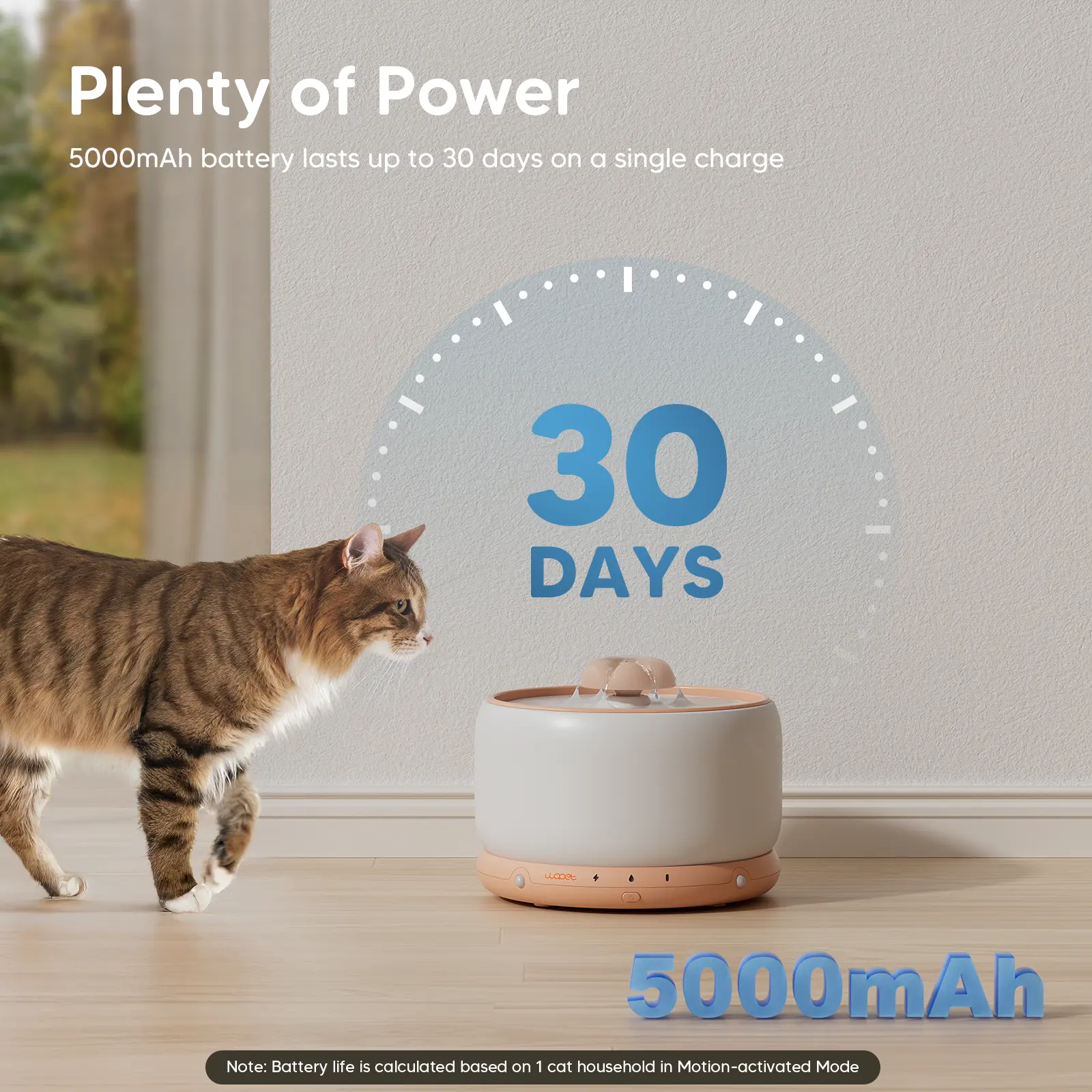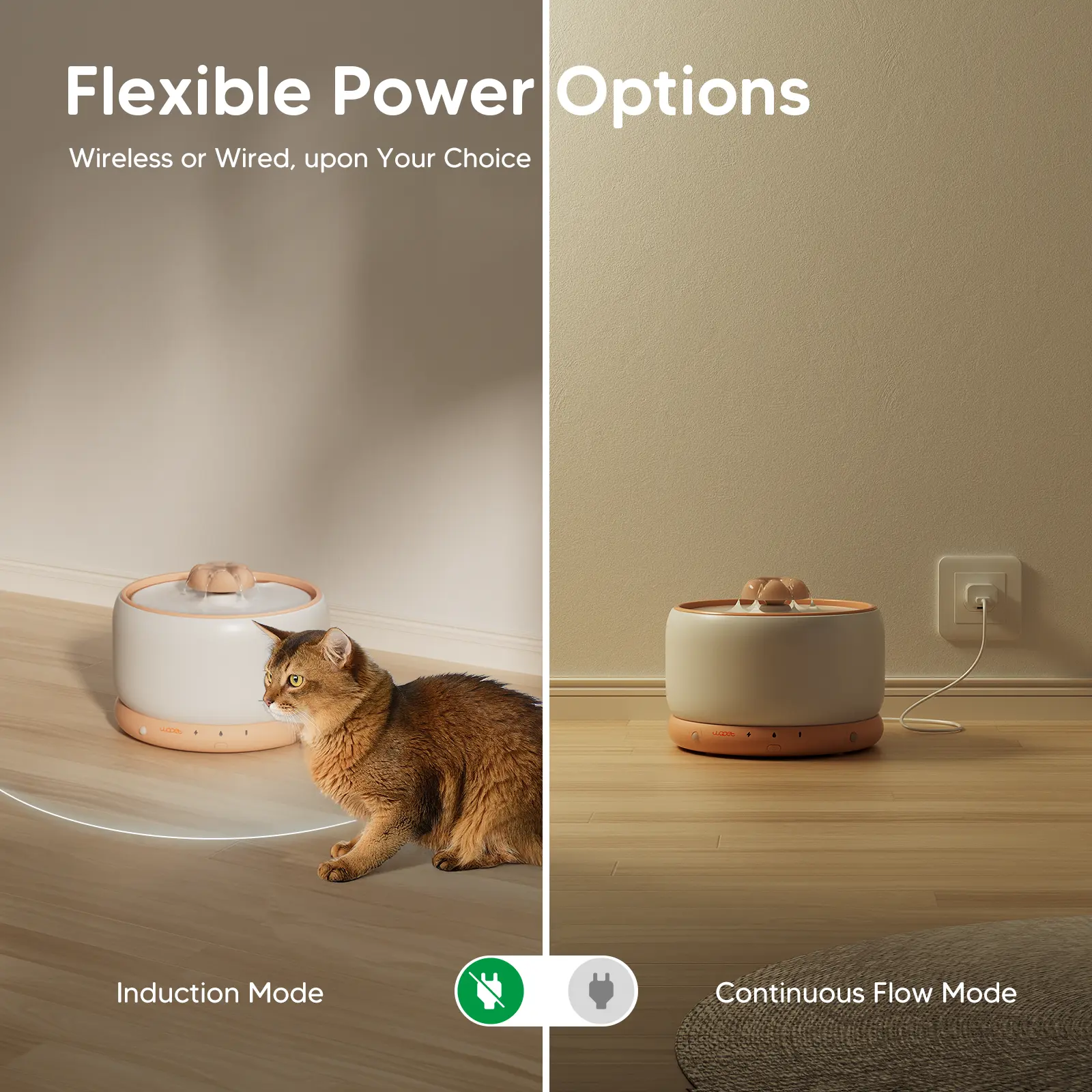Cats need to consume about four ounces of water per five pounds of lean body fat — and that’s per day. That’s why a lot of pet owners invest in cat fountains! After all, they’re an excellent source of hydration for your pet.
However, there is the problem of proper maintenance. If you don’t do it well, these fountains can become a literal breeding ground for mold! And with mold, you can’t escape the health risks for both you and your cat.
So the real question is this: How to prevent mold in cat water fountains? Luckily for you, there’s an easy way to go about understanding this, and we’re here to help.
Let’s understand the causes of mold growth, how to prevent it, and, perhaps most importantly, why investing in a high-quality fountain like those from WOpet can make all the difference.

Why Does Mold Grow in Cat Water Fountains?
Mold develops best when it finds both warmth and plenty of moisture. A water fountain designed for cats offers an ideal environment for mold to multiply because poor maintenance practices cannot stop its growth.
The types of mold that can develop here include:
● Black Mold in Cat Water Fountains (Stachybotrys chartarum): The most concerning type, as it produces harmful mycotoxins.
● Pink Mold in Cat Water Fountains (Serratia marcescens): Usually mistaken for mold. It is instead just a bacterial growth that lives in damp conditions.
● Purple Mold in Cat Water Fountains: Less common but still problematic. Can indicate the presence of fungi and bacteria.
If left unchecked, these molds contaminate the water in the fountain and can lead to problems like digestive issues, respiratory problems, or allergic reactions in your cat and even cause health issues for you, which we’re going to cover as we move forward.
Signs of Mold in Your Cat’s Water Fountain
Signs that your cat’s drinking water is no longer safe include:
● Slimy residue on the bowl or fountain components
● Discoloration (black, pink, or purple spots)
● Musty or unpleasant odors
● Cloudy or murky water
● Visible mold spores floating in the water
If you find any of these signs in your cat’s water fountain, then there’s a high chance you or your cat will face certain health issues.
And while you’ll want to circumvent them, you also have to understand what these health problems might entail before you consider how to prevent them.

Health Issues From Mold in Cat Water Fountain
While the source of the problem — mold in cat water fountain — remains the same, the health problems you and your cat face may not be the exact same. However, both can be difficult, which is why you should find out what they can be.
Cats affected by mold contamination from water fountains may develop these medical conditions.
● Respiratory Issues: The attack of spores on breathing organs causes your cat to cough and sneeze while wheezing and develop breathing problems. When asthma-afflicted cats have one or more existing health problems, the situation becomes extremely dangerous during periods of mold exposure.
● Digestive Problems: Mold exposure produces digestive health problems that trigger vomiting together with diarrhea and appetite reduction in affected cats.
● Skin Irritations: Allergic reactions to mold exposure cause skin irritations that produce itchiness as well as rashes and push your cat to groom compulsively and potentially lead to loss of fur and skin infections.
● Weakened Immune System: Mold exposure that continues without notice can persist to weaken your cat's immune system. Exposure makes them vulnerable to infections along with illness which leads to overall increased sickness.
● Lethargy/Behavioral Changes: Mold-related discomfort could lead your cat to demonstrate behavioral shifts together with lethargy as well as display increased irritability which becomes noticeable later in the course of the illness.
The toxic conditions of mold exposure lead people to experience diverse health complications as follows:
● Allergic Reactions: Exposure to mold spores causes allergic reactions leading to symptoms that comprise sneezing and nasal discharge together with watery eyes and skin swelling. When mold-sensitive people come across mold spores their symptoms usually become more severe.
● Respiratory Problems: Mold spores inhaled through the airways cause breathing difficulties which could potentially evolve into asthma attacks for individuals already suffering from asthma.
● Sinus Infections: Breathing in mold particles can cause sinus irritation that could become severe enough for humans to develop chronic sinusitis alongside congestion and sinus infections.
● Headaches and Fatigue: The symptoms of mold exposure include ongoing headaches which may accompany unexplained fatigue along with overall tiredness and malaise.
● Long-Term Health Risks: Chronic lung conditions together with neurological symptoms can emerge as the primary dangers for your health when exposed to mold over an extended period.

How to Prevent Mold in Cat Water Fountains
1. Choose a High-Quality Cat Water Fountain
Different cat water fountains demonstrate varying degrees of mold susceptibility depending on their manufacturing quality and design integrity.
A solution can be found in WOpet fountains because they use BPA-free materials combined with filter technology that stops mold and bacterial development.
2. Clean Your Cat’s Water Fountain Regularly
Keeping your water fountain clean by periodic maintenance remains one of the most effective means to stop mold from forming. A basic procedure exists for fountain cleaning which involves the following steps:
Step 1: Begin by removing all separate elements from your fountain device.
Step 2: Start by scrubbing the pump as well as the water reservoir with pet-friendly brushes.
Step 3: Dissolve equal parts white vinegar and water into a soak container and let fountain parts sit in the mixture for ten to fifteen minutes. A mixture of white vinegar and water will destroy all mold along with bacteria.
Step 4: This step requires complete rinsing to get rid of any remaining vinegar substance.
Step 5: Reassemble the fountain.
The best achievable results require performing a complete fountain cleaning session twice per week.
3. Change the Water Frequently
Stagnant water acts as one of the primary reasons that leads to mold development. The replacement schedule for fountain water should include daily or twice-daily changes and occurs most urgently following maintenance procedures.
Regularly changing the water schedule will help maintain fresh water free from any potential contaminating substances. The utilization of clean filtered water minimizes impurities which trigger mold formation so mold development in the fountain becomes less likely.
4. Add a Safe Cleaning Agent
Replacement of fountain water should be accompanied by adding suitable antifungal agents to the water tank when necessary. Using this method will effectively prevent mold development.
The choice of cleansing product matters because you need to pick pet-friendly hydrogen peroxide or apple cider vinegar which ensure feline safety during cleaning.
5. Use a Filtered Water Fountain
Your filtered cat water fountain reduces mold development since its filtering mechanism catches debris along with hair and bacteria that prevent water contamination. High-quality fountains, like WOpets’, utilize multiple filtration layers to maintain pure drinking water throughout each use period.
6. Regularly Replace Filters
Regular replacement of filters remains essential because debris accumulation will decrease their ability to protect the water from contaminants. According to the manufacturer's guidelines and personal usage recommendations, you should change the filter between two and four weeks.
7. Keep the Fountain in a Cool, Dry Area
You can minimize black mold in cat water fountains by placing them in shaded areas with sufficient ventilation during storage. A dehumidifier serves as an effective tool for areas which need humidity reduction in rooms with high moisture content.
8. Use Stainless Steel or Ceramic Fountains
Plastic fountains are more sensitive to shaping from scratches that allow excessive growth of bacteria and mold. The better choice for fountains includes stainless steel and ceramic materials because these fountain types offer both higher durability and easier maintenance with automatic mold resistance.

Why WOpet Cat Water Fountains Are the Best Choice
If you’re still struggling with mold in your cat’s water fountain despite all maintenance or filtration options, it might be time to upgrade to a better one. Consider WOpet, which significantly reduces your risk of mold.
Here’s why the WOpet cat water fountain is the best choice for you:
● This fountain includes effective filtration mechanisms that filter both debris and bacteria from the water.
● The product contains high-quality materials that are BPA-free while offering durability since they resist both mold growth and bacterial growth.
● The fountain is designed for easy cleaning through its disassembly feature for complete maintenance.
● The WOpet fountain operates so silently that it delivers a serene drinking experience to your pet.
● This product also assures and encourages your pet’s hydration with a continuous flow of water, promising better kidney health for your cat.
Final Thoughts
Mold in cat water fountains is a serious problem, and you have to tackle it promptly with proper maintenance and preventative measures. You must clean your fountain regularly, change the water frequently, and, most importantly, invest in a high-quality product.
We recommend a WOpet fountain, which will help you prevent black, pink, and purple mold in cat water fountains.
Keep your cat’s water free from contamination. Your cat's health along with hydration depends on your selection of a proper water fountain combined with proper hygiene practices. Ready to upgrade? Check out the best options at WOpet today.
Source from: How to prevent mold in cat water fountains

Ali Raza 8 months ago
Locksmith course: unlock a secure and rewarding career! Learn essential skills like key cutting, lock installation, and advanced security systems through expert training. Whether you're starting fresh or enhancing your expertise, this course offers hands-on experience and certification. With increasing demand for skilled locksmiths, now is the perfect time to invest in your future. Gain the knowledge, master the craft, and open doors to new opportunities today!